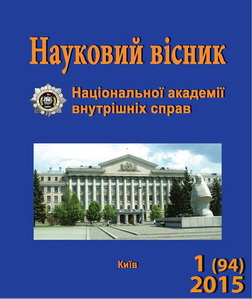Procedural status of a victim: challenges and ways of improving
Keywords:
procedural status, the victim, the implementation of the right to protection of victims
Abstract
Changes in the criminal procedural legislation that occurred in 2012 in Ukraine, created the necessary prerequisites for the functioning of the legal, social state and enforcement of procedural rights of participants in criminal proceedings. Objects that are taken under the protection of criminal offences with the norms of the CPC are: personality; society; state. The objects of protection are rights, freedoms and legitimate interests of participants of criminal proceedings. The current criminal procedure code of Ukraine determines the order in criminal proceedings and contains innovations, which, until recently, were not enshrined in the provisions of the criminal procedure law. One of them is the dedication of a separate paragraph of Chapter 3 of the CPC to the victim, which is evidence of selfimportance that is given to the victim in criminal proceedings. In accordance to Art. 55 of the Code of criminal procedure, a victim in criminal proceedings can be a physical person who has been damaged morally, physically or whose property has been damaged by a criminal offence, as well as a legal entity, whose property has been damaged by a criminal offence. They can be citizens of Ukraine, foreigners and persons without citizenship. A legal entity is determined on the basis of the provisions of articles 80–112 of the Civil Code. It is pointed out quite correctly that a legal entity injured by a crime has the right to submit only a civil action for recovery of such damages in criminal proceedings, that is not equal to recognizing it the victim with appropriate legal status. The rights of the victims are significantly wider than the rights of the plaintiff, who has only the right to submit a civil action. So fixing on the constitutional level the equality of all forms of ownership existing today in the criminal procedural legislation in the case of causing damage by the offense, a physical person is more secure than a legal entity because having submitted a civil action, he uses dual legal status of the victim and the plaintiff, while a legal entity under similar conditions has only the legal status of the plaintiff, whose scope of rights is much narrower than the rights of the victim. It should be noted, that provisions of the current criminal procedure legislation of Ukraine regulating the status of the victim are analyzed, the issues of protection of rights of the victim are discussed, and the ways of its improvement are offered in this article. Domestic and foreign regulatory legal acts of Latvia, Republic of Moldova and Kazakhstan relating to procedural status of the victim are thoroughly analyzed as well.Downloads
Download data is not yet available.
Abstract views: 79 PDF Downloads: 169
How to Cite
[1]
Solonova, O. 1. Procedural status of a victim: challenges and ways of improving. Scientific Herald of the National Academy of Internal Affairs. 94, 1 (1), 139-145.
Issue
Section
Combating crimes: theory and practice
- Authors reserve the right to authorship of their own work and transfer to the magazine the right of the first publication of this work under the terms of the Creative Commons Attribution License, which allows other persons to freely distribute published work with mandatory reference to authors of the original work and the first publication of an article in this magazine.
- Authors have the right to enter into separate additional agreements on non-exclusive dissemination of the work in the form in which it was published in the journal (for example, to post an article in the institution's repository or to publish as part of a monograph), provided that the link to the first publication of the work in this journal is maintained.
- The journal's policy allows and encourages the posting of articles by authors on the Internet (for example, in electronic storehouses of institutions or on personal websites), both before the submission of this manuscript to the editorial office and during its editorial processing, as this contributes to the creation of a productive scientific discussion and positively affects the efficiency and dynamics of citing the published work.




